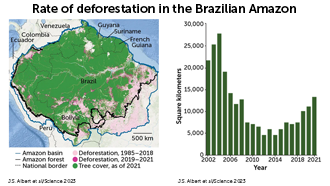Search Results
Covering Carbon
Climate scientists are continuing to develop new methods to sequester atmospheric carbon to help curb climate change. In this activity, students will learn about how carbon can be sequestered through the burial of organic material and review the carbon cycle. Students will practice using percent by mass concepts and dimensional analysis to calculate how much wood would need to be buried to achieve climate targets by the year 2060. As an optional extension, students may then develop a plan to mitigate greenhouse gas production that utilizes biomass burying techniques.
Do the photosynthesis and respiration shuffle
Students will review the components of respiration and photosynthesis reactions to illustrate how the two are complementary. Then students will investigate what impact megafire smoke may have had on photosynthesis for California nut trees. Then students will apply their knowledge by predicting the outcome for photosynthesis and respiration in several scenarios.

Amazon deforestation
Scientists agree that the Amazon is in grave trouble because of human activities, such as deforestation, and climate change. Past studies have suggested certain rates of deforestation would trigger the Amazon to transform into a savanna, but many scientists now say the forest probably doesn’t have a single, clear tipping point. Still, researchers are working to understand what needs to be done — and how soon — to save the forest. Use the map and graph titled “Rate of deforestation in the Brazilian Amazon” to have students analyze the area and rate of deforestation in the Amazon.
Immunity and polar bear pathogens
Students will learn how their bodies help protect them from bacteria, viruses and other foreign invaders. Have students review the major components of the immune system and investigate the life cycles of a few prevalent pathogens of polar bears, focusing on the mode of transmission and effects of being infected by the pathogen. Students will then infer why polar bears are being exposed to these pathogens more regularly.

Methane in the Atmosphere
To tackle our warming climate, we’ll need to rein in emissions of carbon dioxide, but there’s another greenhouse gas at play: methane. Decreasing methane concentrations may be the best bet for stopping rising temperatures in the short term.
Coral Conference
Coral reefs are one of the most biodiverse ecosystems on the planet. Along with providing food and shelter for a variety of marine organisms, coral reefs reduce erosion and protect coastal cities from storms. However, coral reefs are threatened by the effects of climate change. In this activity, students will model the complex interactions that occur within corals, their ecosystem and the Earth’s spheres to learn about how climate change harms coral reefs. After modeling how these interactions change with increasing ocean temperatures, students will brainstorm potential ways to solve or mitigate coral bleaching.
Covering data literacy
Students will work in groups to answer questions about graphs and data visualizations. Then, they will discuss data literacy and how graphs can promote misinformation
Designing GMO Campaigns
Humans have modified organisms for millennia through selective breeding and other techniques. But only in the past few decades have people gained the ability to directly alter organisms’ DNA to create Genetically Modified Organisms (GMOs). GMOs can help advance fields such as medicine and agriculture. In this activity, students will learn more about GMOs and their uses before creating an awareness campaign to address GMO misconceptions.
Solving Hard-to-Reach Problems with ROVs
Remotely operated vehicles, or ROVs, are often used in environments that would be unsafe or difficult for people to enter to explore. In this activity, students will think critically about how engineering practices can be used to monitor environmental issues or solve real-world problems before designing and modeling an ROV that could be used to investigate a real-world problem impacting their local environment.
Pink diamonds
Colliding tectonic plates might make your diamond blush. Learn how differences in crystal structure give rise to distinctive physical differences, such as the rare pink diamonds of Western Australia. Answer questions about the value of skepticism in science and discuss how uncovering the history of our planet can give us a treasure-hunting lead.
Social sharing
Working in a social group provides a variety of benefits, including the ability to learn from others and share resources. However, disadvantages can also come with working in a social group. In this activity, students will brainstorm and discuss the pros and cons of social behaviors in a variety of realistic situations. After considering how disturbances affect social behaviors, students will write a paper that evaluates the relationship between disturbances, social behaviors, and population distributions.
Shining light on photosynthesis
Ever wonder how soil and seeds transform into bushes and trees? And why do these plants have specific requirements for light and water? Are there conditions that push plants to the brink? Explore such questions by taking a deep dive into the chemical processes of photosynthesis. Create a series of comics to illustrate how green plants convert light energy into stored chemical energy. Then, investigate how changes to light, water and temperature can impact plants’ ability to photosynthesize and how plants can adapt when conditions aren’t ideal.